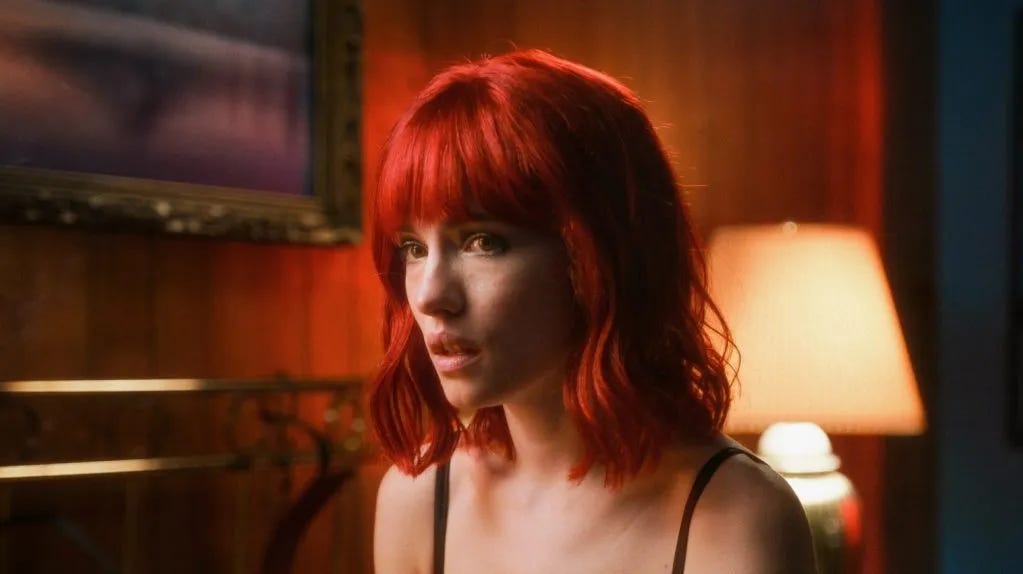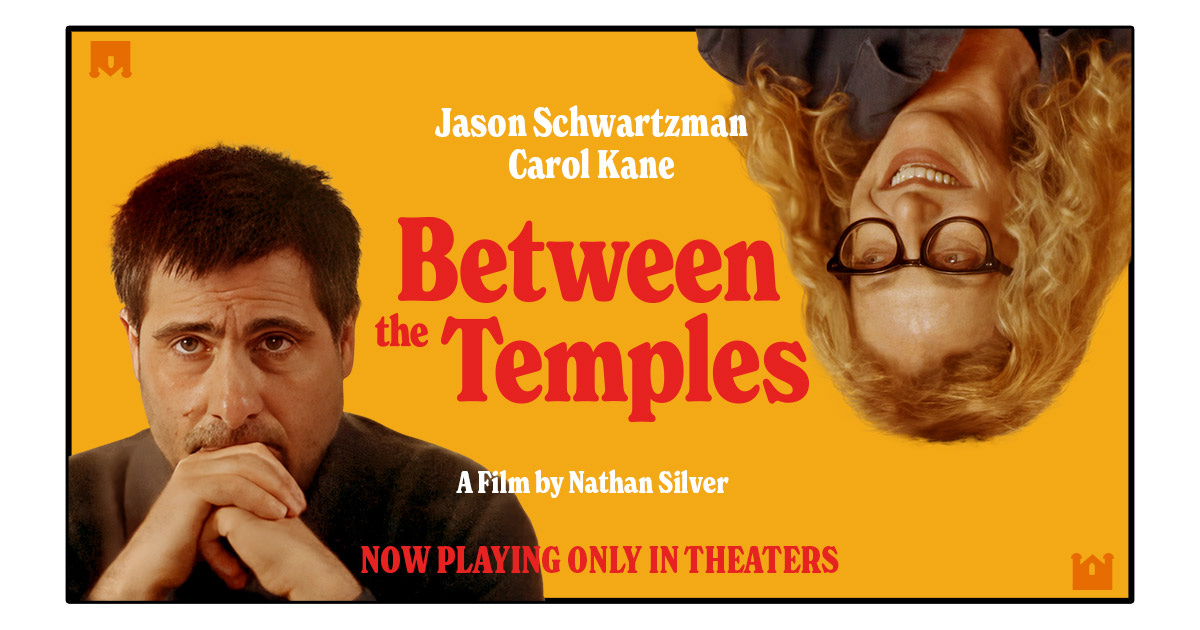In Review: ‘Strange Darling’ and ‘Between the Temples’Checking in on the indies during the late-summer doldrums.Before we get started, one last reminder: We’ve got a Bulwark Live event coming up next week on Thursday, Sept. 5 right here in Dallas. I’ll be there, but, more importantly, people you know from TV like Tim and Sarah and Bill will be there! So will Adam Kinzinger! It’s going to be fun, I can’t wait to see everyone. In a tongue-in-cheek tweet the other day, Variety suggested Deadpool and Wolverine will hit number one at the weekend box office again “due to the sheer lack of compelling options.” One-half of this tweet is true: Deadpool and Wolverine is likely to reign at the box office this week. The other half? About there being no compelling options? I’m gonna have to go ahead and sort of disagree with you there. It seems that the preferred thing to do when discussing Strange Darling is to tell people that they should go in cold, that they shouldn’t read any reviews, and that they should skip all the ads. The point being that this is such a topsy-turvy thriller that any pre-knowledge at all will spoil your enjoyment of it. I think the film’s cleverness is a hair oversold for reasons I’ll get into momentarily, but that’s neither here nor there: If you’re in the mood for a good-looking, well-acted, deeply provocative thriller, stop reading and get your butt to a theater to watch Strange Darling. A card informs us that we’re about to watch the final murders of a notorious serial killer who stalked the Pacific Northwest and the title of the film itself informs us that this is a thriller told in six chapters; the first chapter we watch is number three, and it involves the Demon (Kyle Gallner) chasing the Lady (Willa Fitzgerald) down a forest-lined road. She’s bleeding from the head as she steers her Pinto in pedal-mashing terror; he’s focused, twitchy, and rage-filled as his truck bears down on her. When I say the film’s cleverness is oversold, it’s this nonlinear structure to which I refer; writer-director JT Mollner is clearly hiding the ball, and once you realize his hand is behind his back, you start to wonder what, precisely, led to the sequence of events we’re seeing now. Why is she being hunted? What has she, perhaps, done? Is he really the villain of this picture? On one level, this cleverness is somewhat superficial: there’s a twist and you have to hide it and an easy way to hide it is by starting in media res. On the other, though, it serves an important thematic point about the dangers of relying on preconceptions; the superficiality of the cleverness hides a deeper, daringly provocative premise. I won’t spoil it fully, but I will say that Strange Darling is closer in spirit to Gone Girl than any film I’ve seen recently. Mollner and Fitzgerald toy with ideas of trust and social conventions and the way sociopaths exploit both of these to further their ends at the expense of everyone else. What’s terrifying about this movie isn’t the blood or the gore but the idea that we are all more or less at the mercy of someone who knows how to push the proper buttons, who knows society’s cheat codes. Flabby, unctuous slogans that look good on a placard or can be deployed to gain sympathy in a professional setting are easily dissected by a scoundrel’s scalpel. Fitzgerald and Gallner are incredibly compelling, delivering the sort of performances that demonstrate complete mastery of both the screenplay and their own bodies. They’re hard roles to get right—particularly with the nonlinear screenplay bouncing audiences around, keeping us mildly off-kilter—but the two of them absolutely crush it, each in turn terrifying and heartbreaking as the film hops back and forth through time. Of note is that the film is shot by Giovanni Ribisi, the actor, in his first cinematography credit that’s not a short or a music video. Shot on 35mm,it’s a good-looking movie—grainy, with the occasional imperfection inherent to film flashing through as if the print were 35mm rather than a digital cinema package beamed into my local AMC—and you just know Ribisi’s been waiting decades now to break out the split-diopter when we get two of them back-to-back. The Lord loves a working man and a split diopter. Strange Darling is one of the most incendiary movies of the year, one that is sure to spark discussions once a critical mass of folks get a chance to see it. Do yourself a favor and check it out in a theater, where it will command your attention at all times. Between the Temples is another film that subverts your expectations, though director and co-writer Nathan Silver does it more straightforwardly. Ben Gottlieb (Jason Schwartzman) is a cantor at a synagogue in New York, though one with a problem: he can’t sing. Luckily he can still teach the bar and bat mitzvah classes (and his mothers are big donors to the temple), which gives him some time to get over the passing of his wife, a novelist who slipped on some ice after drinking, hit her head, and died. Ben lives at home with his mothers, Judith (Dolly de Leon) and Meira (Caroline Aaron), who keep trying to set him up with available women, going so far as to make him a JDate profile surreptitiously and set him up with the local rabbi’s daughter, Gabby (Madeline Weinstein). Ben’s in a bad place. When we meet him he’s picking fights with random guys in bars where he’s chugging mudslides, and I don’t know that there’s a bigger cry for help in the movies than “girl-drink drunk throwing down on big guy in bar.” After getting popped in the eye he lays down in the road, hoping a semi will finish the job. It doesn’t, life goes on, and he finds purpose in the form of Carla Kessler (Carol Kane), an older woman who wants to get her bat mitzvah. Between the Temples is a romcom of sorts, though the romance and the comedy are both quite dry. I say this with the highest praise: It’s the sort of movie that inspires mirthful chuckles from the interaction between the actors, from the timing of the responses and reactions. Yes, there are a handful of comic types; when Carla’s annoying son, Nat (Matthew Shear), announces that he cannot support her bat mitzvah because he’s an ardent atheist, you just know the sort of smug, Reddit-infused mood he has to offer. But the humor stems from the innate awkwardness of human existence, and editor John Magary does a good job of heightening that awkwardness, particularly in a bravura sequence near the end at a Shabbat dinner bringing together the film’s various strands. I love the actors assembled by Silver and casting director Kate Antognini; Schwartzman, whom I’ve enjoyed and identified with since Rushmore, and Kane, a living legend, are great, obviously. But the supporting roles are also perfectly cast. Some, like Robert Smigel (the SNL alum and puppeteer of Triumph the Insult Comic Dog) and Keith Poulson (who I loved in Bob Byington’s Frances Ferguson and Somebody Up There Likes Me), I happily recognized. Others were new to me, and they were uniformly great. Weinstein (no relation to, you know) gives off perfect nervous energy as Gabby, while de Leon and Aaron as Ben’s amusingly diverse moms radiate concerned Jewish-mother energy. Even the actors who get a single scene, like Pauline Chalamet as a woman with a dark secret who meets up with Ben for a JDate, really shine. It’s just excellent work all around. Both of these movies are in theaters now, though who knows for how long. Strange Darling is down to one showing a day at my area AMCs; Between the Temples still gets a full day of screenings at the Angelika Film Center & Café, but few theaters beyond that. It’s a shame, really, and indicative of a complete inability to grow a film through word of mouth—or to have faith that such an audience can develop at all. Platforming (that is, the practice of releasing a movie in New York and Los Angeles and a few other big cities, then slowly expanding as buzz builds) isn’t entirely dead—Everything Everywhere All at Once did a really good job of creating buzz and building momentum in 2022—but it’s harder in an age of instant gratification and the demand for everything to be available everywhere all at once. Combined with the audience’s penchant for posting videos of movie screens in the hopes of getting 27 likes on Twitter, one can understand why the creators of Strange Darling, worried as they are about spoilers, want to avoid a slower rollout. Still, it’s a little sad that nothing really gets the chance to grow and breathe organically. Word of mouth takes time to develop, particularly for original productions. Hopefully, these movies get the eyeballs they deserve once they hit home viewing. You’re a free subscriber to Bulwark+. For unfettered access to all our newsletters and ad-free and member-only podcasts, become a paying subscriber. Did you know? You can update your newsletter preferences as often as you like. To update the list of newsletter or alerts you received from The Bulwark, click here. |



